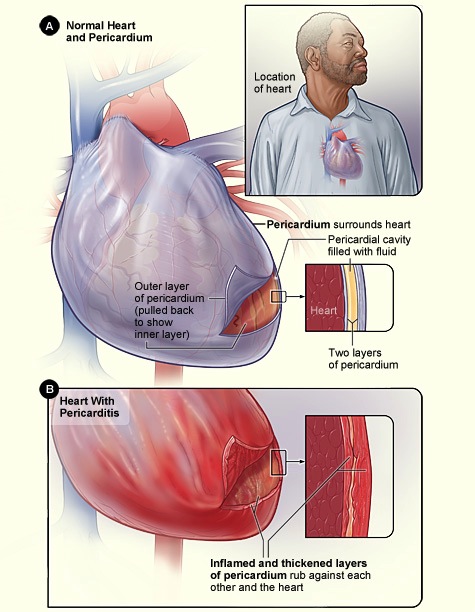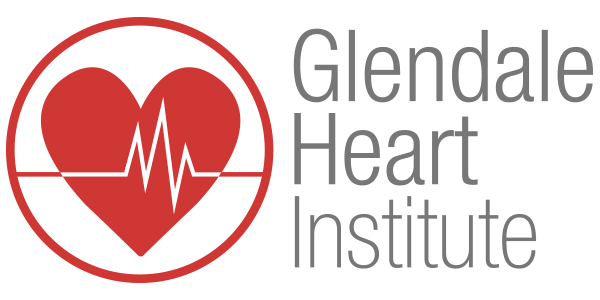Pericarditis (PER-ih-kar-DI-tis) is a condition in which the membrane, or sac, around your heart is inflamed. This sac is called the pericardium (per-ih-KAR-de-um).
The pericardium holds the heart in place and helps it work properly. The sac is made of two thin layers of tissue that enclose your heart. Between the two layers is a small amount of fluid. This fluid keeps the layers from rubbing against each other and causing friction.
Pericardium
Figure A shows the location of the heart and a normal heart and pericardium (the sac surrounding the heart). The inset image is an enlarged cross-section of the pericardium that shows its two layers of tissue and the fluid between the layers. Figure B shows the heart with pericarditis. The inset image is an enlarged cross-section that shows the inflamed and thickened layers of the pericardium.
In pericarditis, the layers of tissue become inflamed and can rub against the heart. This causes chest pain, a common symptom of pericarditis.
The chest pain from pericarditis may feel like pain from a heart attack. More often, the pain may be sharp and get worse when you inhale, and improve when you are sitting up and leaning forward. If you have chest pain, you should call 9–1–1 right away, as you may be having a heart attack.
Overview
In many cases, the cause of pericarditis is unknown. Viral infections are likely a common cause of pericarditis, although the virus may never be found. Bacterial, fungal, and other infections also can cause pericarditis.
Other possible causes include heart attack or heart surgery, other medical conditions, injuries, and certain medicines
The pericardium holds the heart in place and helps it work properly. The sac is made of two thin layers of tissue that enclose your heart. Between the two layers is a small amount of fluid. This fluid keeps the layers from rubbing against each other and causing friction.
Pericardium
Figure A shows the location of the heart and a normal heart and pericardium (the sac surrounding the heart). The inset image is an enlarged cross-section of the pericardium that shows its two layers of tissue and the fluid between the layers. Figure B shows the heart with pericarditis. The inset image is an enlarged cross-section that shows the inflamed and thickened layers of the pericardium.
In pericarditis, the layers of tissue become inflamed and can rub against the heart. This causes chest pain, a common symptom of pericarditis.
The chest pain from pericarditis may feel like pain from a heart attack. More often, the pain may be sharp and get worse when you inhale, and improve when you are sitting up and leaning forward. If you have chest pain, you should call 9–1–1 right away, as you may be having a heart attack.
Overview
In many cases, the cause of pericarditis is unknown. Viral infections are likely a common cause of pericarditis, although the virus may never be found. Bacterial, fungal, and other infections also can cause pericarditis.
Other possible causes include heart attack or heart surgery, other medical conditions, injuries, and certain medicines

Pericarditis can be acute or chronic. “Acute” means that it occurs suddenly and usually doesn’t last long. “Chronic” means that it develops over time and may take longer to treat.
Both acute and chronic pericarditis can disrupt your heart’s normal rhythm or function and possibly (although rarely) lead to death. However, most cases of pericarditis are mild; they clear up on their own or with rest and simple treatment.
Other times, more intense treatments are needed to prevent complications. Treatments may include medicines and, less often, procedures or surgery.
Outlook
It may take from a few days to weeks or even months to recover from pericarditis. With proper and prompt treatment, such as rest and ongoing care, most people fully recover from pericarditis. Proper treatment also can help reduce the chance of getting the condition again.
Content Resource: http://www.nhlbi.nih.gov/health/health-topics/topics/peri/
Both acute and chronic pericarditis can disrupt your heart’s normal rhythm or function and possibly (although rarely) lead to death. However, most cases of pericarditis are mild; they clear up on their own or with rest and simple treatment.
Other times, more intense treatments are needed to prevent complications. Treatments may include medicines and, less often, procedures or surgery.
Outlook
It may take from a few days to weeks or even months to recover from pericarditis. With proper and prompt treatment, such as rest and ongoing care, most people fully recover from pericarditis. Proper treatment also can help reduce the chance of getting the condition again.
Content Resource: http://www.nhlbi.nih.gov/health/health-topics/topics/peri/
Cardiac Specialty Care
• Structural Heart Disease
• TAVR
• CardioMEMS (Heart Failure)
• PFO Closure
• TAVR
• CardioMEMS (Heart Failure)
• PFO Closure
• Coronary Intervention
• Complex Higher-Risk (And Indicated) Patients (CHIP) Angioplasty
• Atherectomy
• Impella and ECMO Support
• Complex Higher-Risk (And Indicated) Patients (CHIP) Angioplasty
• Atherectomy
• Impella and ECMO Support
• Peripheral Angioplasty
• Varicose Vein Treatment (Venous Ablation)
• DVT thrombectomy - IVC filter
• Carotid Stenting
• Varicose Vein Treatment (Venous Ablation)
• DVT thrombectomy - IVC filter
• Carotid Stenting
• Rhythm Management
• Pacemaker
• Holter Monitoring
• Exercise Stress Test
• Echocardiography
• Nuclear Stress Test
• Enhanced External Counterpulsation (EECP)
• Pacemaker
• Holter Monitoring
• Exercise Stress Test
• Echocardiography
• Nuclear Stress Test
• Enhanced External Counterpulsation (EECP)
